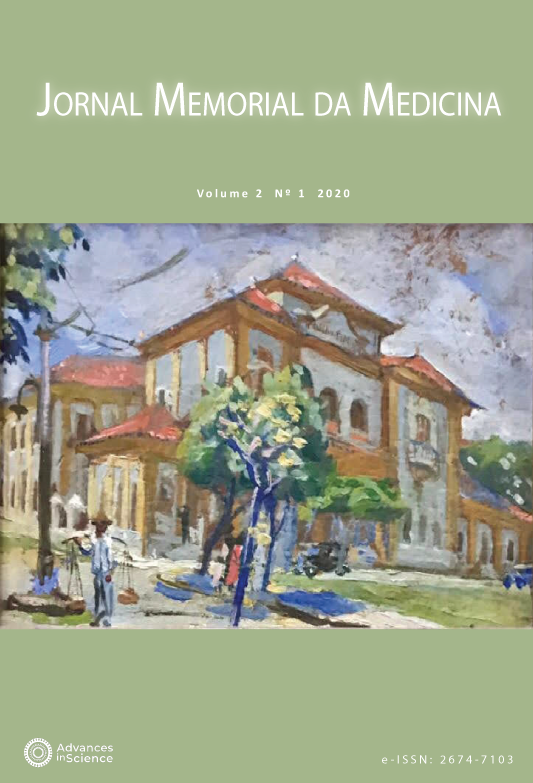Ruptura de aneurisma intracraniano tratado com oclusão cirúrgica e craniectomia descompressiva: relato de caso
Visualizações: 830DOI:
https://doi.org/10.37085/jmmv2.n1.2020.pp.15-19Keywords:
Aneurisma intracerebral, Hemorragia subaracnóide, Aneurisma roto, Hipertensão intracranianaAbstract
Os aneurismas intracranianos saculares são oriundos da dilatação e enfraquecimento de artérias do polígono de Willis e sua gênese está associada, principalmente, a fatores genéticos, assim como hipertensão arterial sistêmica e tabagismo. A ruptura desses aneurismas leva à hemorragia subaracnoide (HSA), sendo uma importante causa de mortalidade nos serviços de emergência. A terapêutica se concentra na prevenção e tratamento das complicações. Relatamos um caso de uma mulhercom 57 anos admitida no serviço de urgência neurocirúrgica com história de cefaleia súbita intensa e rebaixamento do nível de consciência. Foi realizada tomografia computadorizada do crânio sem contraste que evidenciou HSA escore IV na escala de Fisher e uma arteriografia cerebral observando aneurisma em artéria cerebral média esquerda.
Downloads
References
Hemphill JC, Greenberg SM, Anderson CS, Becker K, Bendok BR, Cushman M, et al (2015) Guidelines for the Management of Spontaneous Intracerebral Hemorrhage: A Guideline for Healthcare Professionals from the American Heart Association/American Stroke Association. Stroke 46:2032-60.
Jauch EC, Saver JL, Adams HP, Bruno A, Connors JJB, Demaerschalk BM, et al (2013) Guidelines for the early management of patients with acute ischemic stroke: A guideline for healthcare professionals from the American Heart Association/American Stroke Association. Stroke 44(3):870–947.
Jüttler E, Unterberg A, Woitzik J, Bösel J, Amiri H, Sakowitz OW, et al (2014) Hemicraniectomy in Older Patients with Extensive Middle-Cerebral-Artery Stroke. N Engl J Med 370(12):1091-100. 4. Mackey J (2014) Evaluation and management of stroke in young adults. Continuum (Minneap Minn) 20:352–69.
Turcato C, Pereira SW, Ghizoni MF (2006) Hemorragia subaracnóide. ACM Arq Catarin Med 35(2):78–84.
Powers WJ, Derdeyn CP, Biller J, Coffey CS, Hoh BL, Jauch EC, et al (2015) American Heart Association/American stroke association focused update of the 2013 guidelines for the early management of patients with acute ischemic stroke regarding endovascular treatment: A guideline for healthcare professionals from the American Heart Association/American stroke association. Stroke 46:3020–35.
Prabhakaran S, Ruff I, Bernstein RA (2015) Acute stroke intervention: A systematic review. JAMA 313:1451–62.
Blok KM, Rinkel GJE, Majoie CBLM, Hendrikse J, Braaksma M, Tijssen CC, et al (2015) CT within 6 hours of headache onset to rule out subarachnoid hemorrhage in nonacademic hospitals. Neurology 84(19):1927–32.
Perry JJ, Alyahya B, Sivilotti MLA, Bullard MJ, Émond M, Sutherland J, et al (2015) Differentiation between traumatic tap and aneurysmal subarachnoid hemorrhage: Prospective cohort study. BMJ (Online).
Raya AK, Diringer MN (2014) Treatment of subarachnoid hemorrhage. Critical Care Clinics 30:719–33.
Lot G, Houdat E, Cophignon J, Casasco A, George B (1999) Combined management of intracranial aneurysms by surgical and endovascular treatment. Modalities and results from a series of 395 cases. Acta Neurochir 141:557-562.
Raftopoulos C, Mathurin P, Boscherini D, Billa RF, Van Boven M, Hantson P (2000) Prospective analysis of aneurysm treatment in a series of 103 consecutive patients when endovascular embolization is considered the first option. J Neurosurg 93(2):175–82.
Byrne JV, Sohn MJ, Molyneux AJ (1999) Five-year experience in using coil embolization for ruptured intracranial aneurysms: Outcome and incidence of late rebleeding. J Neurosurg 90(4):656–63.
Civit T, Auque J, Marchal JC, Bracard S, Picard L, Hepner H (1996) Aneurysm Clipping after Endovascular Treatment with Coils: A Report of Eight Patients. Neurosurgery 38(5):955–61.
Hacein-Bey L, Connoly JRS, Mayer SA, Young WL, Pile-Spellman J, Solomon RA (1998) Complex intracranial aneurysms: combined operative and endovascular approaches. Neurosurgery 43:1304-1313.
Moon JW, Hyun DK (2017) Decompressive Craniectomy in Traumatic Brain Injury: A Review Article. Korean J Neurotrauma 13(1):1.
Gopalakrishnan MS, Shanbhag NC, Shukla DP, Konar SK, Bhat DI, Devi BI (2018) Complications of Decompressive Craniectomy. Front Neurol 9 (NOV):977.
Downloads
Published
How to Cite
Issue
Section
License
Os direitos autorais para artigos publicados no Jornal Memorial da Medicina são do autor, com direitos de primeira publicação para a revista. Em virtude de aparecerem nesta revista de acesso público, os artigos são de uso gratuito, com atribuições próprias, em aplicações educacionais e não comerciais. O Jornal Memorial da Medcina permitirá o uso dos trabalhos publicados para fins não comerciais, incluindo direito de enviar o trabalho para bases de dados de acesso público. Os artigos publicados são de total e exclusiva responsabilidade dos autores. Há encargos para submissão no processamento de artigos (Articles Processing Charge - APC).







